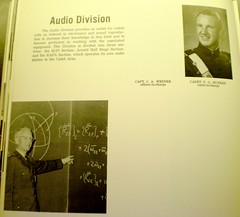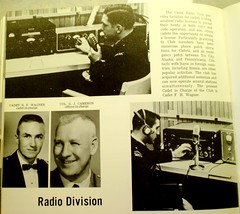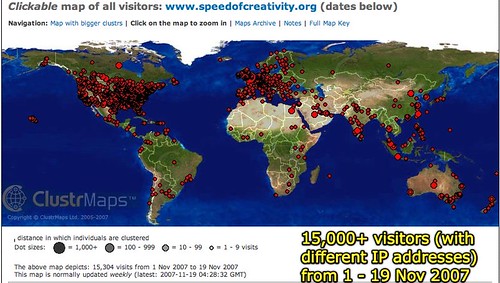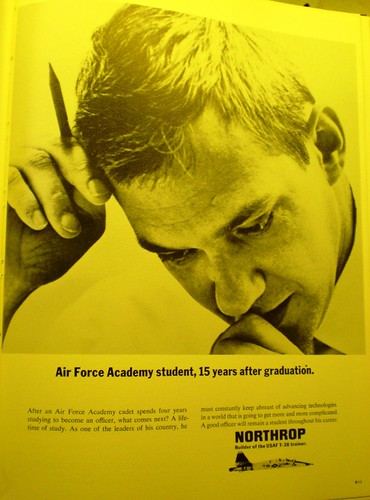This Thanksgiving I’ve been looking at some of my Dad’s college yearbook photos from 1963. The context for this is an upcoming memorial ceremony for one of Dad’s classmates (Pat Wynne) who was shot down over North Vietnam in 1966, declared MIA, and later declared KIA in 1977.
As I was looking through his senior annual, I came across several images that caught my eye and were unrelated to his classmate. First, this one of the “Audio Division” at the Air Force Academy:
The explanatory paragraph reads:
The Audio Division provides an outlet for cadets with an interest in electronics and sound reproduction to increase their knowledge in this field and to become proficient in working with the associated equipment. The division is divided into three sections: The Hi-Fi Section, Arnold Hall Stage Section, and the KAFA Section, which operates its own radio station in the Cadet area.
KAFA is still on the air and run by cadets, as 97.7 FM on the Colorado Springs-area radio dial. I wish they were broadcasting on the Internet, as I’d check them out, but it doesn’t appear they’ve yet made that jump into the 21st century communications landscape. I wonder if any of the cadet radio broadcasters have attempted to get KAFA to join the list of webcasting radio stations on Live365.com?
The second image which caught my eye was for the “Radio Division:”
It reads:
The Cadet Radio Club provides facilities for cadets holding amateur radio licenses to pursue their hobby in both voice and code operation, and also offers cadets the opportunity to obtain a license. Particularly gratifying to Club members have been numerous phone patch operations for Cadets and an emergency patch between Tin City, Alaska, and Pennsylvania. Contacts with hams in foreign countries, including Russia, are other popular activities. The club has acquired additional antennas and can now operate several stations simultaneously.
Consider how far “we” (as a society with access to the Internet) have come in terms of our personal access to global audio and radio publishing potentials since 1963?! I wonder if people in 1963 had an inkling of the way communication networks would grow in the years ahead? It seems strange to think about getting a “license” for podcasting, yet that was (and still is) required by the FCC in the United States to legally operate an amateur radio in many frequencies. According to the Wikipedia entry for amateur radio under “licensing:”
In all countries, amateur radio operators are required to pass a licensing exam displaying knowledge and understanding of key concepts. In return, hams are granted operating privileges in larger segments of the radio frequency spectrum using a wide variety of communication techniques with higher power levels permitted. This practice is in contrast to other unlicensed personal radio services such as CB radio, Multi-Use Radio Service, or Family Radio Service / PMR446 that require type-approved equipment restricted in frequency range and power.
Should people who are creating podcast channels be able to take a course and obtain “certification,” similar to the way amateur radio operators do? This may not be a requirement, but it could be a worthwhile process to create. Interesting to consider.
My grandfather on my mother’s side was an avid ham radio enthusiast, and I sometimes wonder if my own love of blogging, podcasting, and digital publication stems in part from a love of communication technologies which I somehow inherited from him. When I look at the HUGE television towers which are just south of our home in Edmond, Oklahoma, and consider the capital investment still required to gain a foothold in the mainstream/traditional broadcast publishing world, I am amazed to consider the communication connections now enabled by Internet connections, blogging and podcasting. My current ClustrMap shows over 15,000 different visitors to my blog in the first nineteen days of November this month:
These red dots on the map of the world never cease to amaze and humble me. What an exciting day it is to be alive, to be literate, and be connected to others via the Internet! I don’t think cadets graduating from the Air Force Academy in 1963 could have dreamed our world would become so interconnected in the decades ahead. I wonder if we’re poised to experience a similar leap in interconnected communications in the next fifty years, entirely unanticipated or unimagined by the current generation? I strongly suspect we are.
While people in 1963 may have not been able to predict the rise of the Internet, cell phone telephony, and the read/write web, the following advertisement from Northrop (now the Northrop Grumman Corporation) included words of both truth and wisdom:
The accompanying text reads:
Air Force Academy student, 15 years after graduation. After an Air Force Academy cadet spends four years studying to become an officer, what comes next? A lifetime of study. As one of the leaders of his country, he must constantly keep abreast of advancing technologies in a world that is going to get more and more complicated. A good officer will remain a student throughout his career.
I think that is both sage advice and an astute observation. It’s no coincidence that the current slogan of the Northrop Grumman Corporation is similarly forward looking:
Northrop Grumman: Defining The Future
It can be easy to get frustrated at the apparent lack of change in many of our schools– what Dr. Seymour Papert refers to as “educational megachange” in his book “The Children’s Machine: Rethinking School in the Age of the Computer.” I am optimistic for many reasons, however, but fundamental among those reasons is the access we now can enjoy to each other via the read/write web. In every other previous era of human history, “regular folks” did not enjoy or experience the access we now have to GLOBAL publishing tools. Certainly Ham radio enthusiasts were able to talk with other Hams around the country and even the world, but those with access to those technologies (to both receive as well as broadcast) were VERY limited in number. A digital divide of access to the Internet still exists, but the increasing levels of access to the web are eye opening.
I have used the term “narrowcasting” when introducing my podcast episodes for quite awhile, but I may be using the wrong term. According to WikiPedia, a “narrowcast” is:
the transmission of data to a specific list of recipients. Cable television is an example of narrowcasting since the cable TV signals are sent only to homes that have subscribed to the cable service. In contrast, terrestrial TV uses a broadcast model in which the signals are transmitted everywhere and anyone with an antenna can receive them.
Under this definition, a podcast is NOT a “narrowcast,” it is certainly a “broadcast.” An email message is a “narrowcast.” A podcast is a “broadcast.” There is theoretically no limit to the number of people who can “receive” and listen to (or watch) a podcast. It is true that only “podcast subscribers” automatically receive the latest episode when it is published, but anyone can “come along” later on the web and download the episode. This asynchronous access to published podcasts makes this technology potentially MORE far reaching and impactful than broadcast television or radio, which (except for DVR recording contexts) require people to be “tuned in” at the time and on the specific channel of the broadcast. Anyone with an Internet connection not filtered/censored for the website hosting a podcast can download and receive it, immediately after it is published or theoretically YEARS afterward, as long as the hosted webpages and podcast files remain available on the open web. (For more on the reasons to publish to the open web, see the “More Than Cool Tools” keynote from K12Online07.)
I think I need to change my podcasting intro script. Broadcasting HAS come a long way. I wonder where we’ll see these technologies go in the years ahead? It’s going to be an exciting ride. Without a doubt, we can still say with confidence (to paraphrase the 1963 Northrop advertisement:)
After [a student] spends [many years studying to become [a graduate], what comes next? A lifetime of study. As one of the leaders of [our world], [s/he] must constantly keep abreast of advancing technologies in a world that is going to get more and more complicated. A good [leader] will remain a student throughout [life].
Technorati Tags:
usafa, kafa, radio, ham, fcc, license, podcast, podcasting, narrowcast, narrowcasting, history, broadcast, broadcasting
If you enjoyed this post and found it useful, subscribe to Wes’ free newsletter. Check out Wes’ video tutorial library, “Playing with Media.” Information about more ways to learn with Dr. Wesley Fryer are available on wesfryer.com/after.
On this day..
- Using the Daum Equation Editor to Format Math Equations for Wolfram Alpha – 2012
- Google Tools Workshops in Oklahoma City: 14-15 December 2010 (flyer) – 2010
- How to publish an audio lecturecast with Podcast Generator (screencast demo) – 2010
- Meet Jonney Shih, Netbook innovator – 2009
- Power of Google Voice Transcriptions comes to YouTube with Automatic Annotations – 2009
- GPS learning in the air and on the highway – 2008
- Oklahoma centennial photos, videos, and reflections – 2007
- Create a skype button – responsibly – 2007
- Residential wifi proliferates – 2007
- 3rd grade website about Africa – 2006




